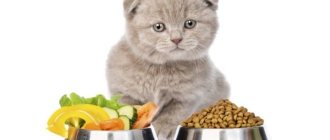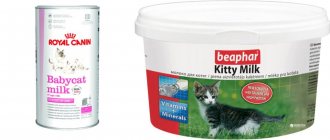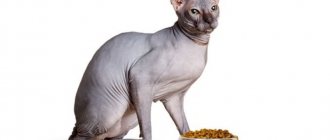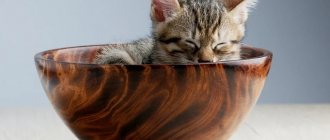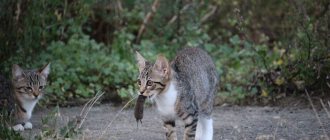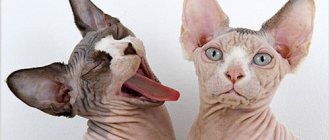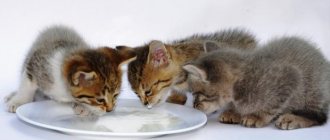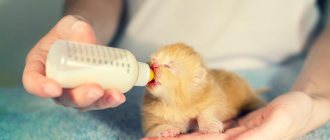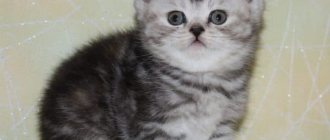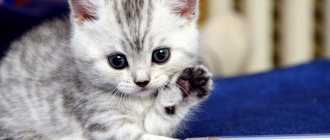Breed Features
Sphynxes combine several breeds of hairless cats. Lack of fur is a mutation fixed by selection . Sphinxes are varied.
Among the breeds there are:
- Fold (Ukrainian Levkoy);
- on short legs (bambino);
- with dog manners (St. Petersburg);
- bald with fur inserts (minskins).
The characteristics of the breed can be seen in representatives of two breeds.
Donskoy
This breed is distinguished by a strong and muscular body with a wide chest. The wedge-shaped head bears tonsil-like eyes and rounded ears. The whiptail may have some hair, but is mostly devoid of it. The limbs are high, the forelimbs are shorter than the hind limbs, thin, but not refined. The toes are large and the feet are powerful.
The skin is soft, delicate, folded, many call it “silk”. The Don Sphynx is divided by type:
- bare (rubber);
- flock (thin, delicate down);
- velor (hair 1-2 mm);
- brush (brush). They do not represent any value, but participate in reproduction.
The breed is characterized by increased sweating. This imposes its own characteristics in skin care and feeding.
Males are larger than females. The average weight of a cat can reach 7 kg, but a cat cannot weigh more than 5 kg. Among Sphynxes, the breed is considered average.
Canadian
If the Don Sphynx is young, the breed is no more than 15 years old, then the Canadian Sphynx is fully formed and stable. The age of the breed is more than 50 years. The baldness gene in this breed, unlike the Don, is recessive. They have no hunger birth, and there are no animals completely not covered with hair.
Body with a well-developed muscle layer. The chest is barrel-shaped, the belly is round. The tail is flexible and thin, similar to a rat's, the proportions are completely preserved. Sometimes a tuft of hair is allowed at the end. The texture of the leather is suede-like. May be covered with fine down.
The weight of an adult cat, as well as a Sphynx cat, varies from 4 to 6 kg. Whatever the breed characteristics of the kitten, it is necessary to feed it in accordance with the requirements of its physiology.
Sphinxes are very diverse. Some of the representatives are slow and lazy, while others are fast, agile, energetic, and playful. The whole lifestyle is reflected on the cat’s body, whose diet needs to be balanced more carefully.
Greater heat transfer (as it is necessary to warm up) and sweating require a higher calorie content in the feed. However, the owner is often concerned about the pet’s overeating and rapid weight gain.
Due to the nature of the breed, the feeding ration should be:
- balanced;
- with a minimum carbohydrate component;
- easily digestible proteins of natural origin;
- optimal amount of fat;
- rich in mineral and vitamin nutrients.
Premium food
Manufacturers of high-quality food produce special mixtures for feeding sphinxes. Let's look at the most popular of them.
Orijen Cat & Kitten
The product for cats is produced in Canada. If you carefully study the label, you will find out that the food is designed not only for adult cats, but also for pregnant cats, as well as kittens.
The food has a high protein content (42%), which is necessary for purebred representatives. The cost of heating the body is compensated by the increased consumption of protein foods. Fats in the feed are present in normal quantities (20%). On mobile, you can scroll the table horizontally with your finger:
| Sources | ||
| proteins | fat | carbohydrates |
| turkey and chicken meat | Animal (chicken) fat | potato |
| bird liver | ||
| fish (pollock, herring, salmon). | ||
Additionally, the production diet includes fruit, vegetable and plant ingredients:
- apples;
- blueberry;
- pumpkin;
- turnip;
- carrot;
- green peas;
- spinach;
- chicory root;
- mint.
In addition, the food contains the daily requirement of vitamins, macro- and microelements.
Purina Pro Plan Delicate
Suitable for adult pets who are too picky about food. The composition of the feed, except for the meat part, is presented:
- rice;
- animal and fish oil;
- yeast;
- egg powder;
- green peas and corn.
The ready-made diet is rich in antioxidants, omega fatty acids and a complex of vitamins. Large dry granules help cleanse teeth and gums of plaque and tartar. Thanks to its unique composition, the food helps normalize digestion.
Choosing a place and dishes
Sphynx cats are independent. No matter how hard the owner tries to accustom them to the “canteen”, they will always find an opportunity to feast on them without permission. A table, a bedside table, a cabinet - there are no barriers for them in reaching the tasty morsel.
According to experienced Sphynx owners, they are omnivores.
Having taken the kitten into the house, the owner is ready to feed it from his plate and spoon. However, a place for a cat's bowl should be determined from early childhood and the animal should be accustomed to it, especially since it is not difficult.
A Sphynx kitten normally enters another environment no earlier than 2-2.5 months. This is an already formed organism with its own manners and character, but it is very easy to train. It is possible to accustom a kitten to a bowl. It is enough to give food only to it.
The bowl should be placed in a place that will:
- accessible. New-fashioned pull-out cabinets make life easier for the owner, but this is not good for the animal. Constant access to water and a bowl of food is a must. You should not allow the sphinx to meow hysterically when asking for food;
- secluded. During the feeding period, the kitten should not be stepped over, pushed aside, pushed away or walked around. Taking a closer look at the animal, you can see where it is pulling its “prey”. This will be a secluded corner, it is advisable to place a bowl of water and food in it;
- with an easy to clean surface. Even if the sphinx cannot pull the food out of the bowl, then in any case, anything can happen, and the eating area should be kept clean.
The requirements for the dishes are as follows:
- bowls should be heavy;
- the dishes should not move or overturn during the consumption of food;
- The material from which the bowl is made should be food grade with an easy to clean surface. Ideally, dishes should be washed after eating food, or, in extreme cases, daily.
Feed replacement
Even the most expensive and elite food can cause digestive upset in a pet. Problems with bowel movements, diarrhea, constipation, and general deterioration in health indicate that the body does not accept the food offered.
The kitten becomes restless, refuses to play with the owner, and eats reluctantly. It is necessary to contact a veterinarian and have the animal examined. If no objective reasons have been identified, then the deterioration of the condition is caused by poor nutrition. In this case, it is necessary to change the food.
The change in diet is approached gradually. Choose another feed manufacturer. Add some new ones to the old granules and offer them to the kitten. Sphynxes are very sensitive to substitution and at first they can sort out their food, choosing the usual one.
The replacement process is lengthy; if the cat categorically refuses to eat the new food, it is necessary to purchase another one. This is how the trial method is used to achieve a complete replacement of nutrition. You need to be patient, because the health of the pet is in the hands of the owner.
What to feed a Sphynx kitten
When thinking about the Sphynx's diet, the last thing you should think about is your convenience. Having taken a living creature into the house, the owner bears full responsibility for its life and health.
The food should be:
- useful;
- balanced;
- nutritious;
- and of course delicious for your pet.
Natural diet
The Sphinx is a carnivore. This means that the feeding ration should consist of:
- fish products;
- meat products including offal;
- fermented milk;
The benefits of a natural diet
Sphynx cats often react with their skin when feeding. Dermatitis, rashes, eczema are nothing more than errors in the preparation of the diet.
If the food is multi-component, then it is almost impossible to identify which component you are allergic to.
Natural feeding is a completely different matter; with its help you can:
- it’s easy to analyze what you’ve fed and identify the allergen;
- choose your own ingredients;
- control variety, quantity and quality.
Flaws
{
Natural feeding is labor intensive. It includes:
- selection and purchase of products;
- transportation and storage of ingredients (with the advent of freezers with storage, the task became easier, but the quality dropped);
- cooking. Involves the presence of special utensils, cooking, grinding;
- storage of finished feed and ingredients in compliance with expiration dates and quality control.
- eggs
Fish products
It is necessary to immediately decide that, in order to avoid serious invasions, either sea fish or fish from inland waters can be used for food, but after thorough boiling (at least 30 minutes after boiling).
There is no need to feed expensive varieties of fish to a cat or even a small kitten. The most affordable hake and pollock are quite suitable and will balance the diet by:
- squirrel;
- minerals (calcium, phosphorus, trace elements);
To balance the fats (Omega-3 acids), it is advisable to introduce fattier varieties of fish into the diet (trim and trim mackerel, herring, salmon).
You can serve your kitten raw fish from the age of 3 months, but before this age it is better to boil it. There is no need to pick out bones and deprive the animal of pleasure and minerals. Fish should be present in the diet daily and account for 40-50% of the total.
Meat products
Preference should be given to fresh, not frozen offal and meat. Alternation:
- beef;
- pork;
- rabbit meat;
- chicken;
- turkey meat;
- If possible, game will make the diet balanced.
You cannot stop at one type of meat or categorically deny, for example, pork. All types are very beneficial for the kitten’s body.
Meat makes up 30% of a cat's daily diet. In this case, 15% of 30 can be allocated to by-products:
- liver (except beef);
- heart (especially beef);
- lungs;
- kidneys;
- poultry gizzards;
- beef tripe.
All organ meats are an excellent source of essential amino acids. With their help it is easy to balance your protein diet.
When preparing food for a kitten, you should take into account that Scythians do not chew food well.
The meat is served in minced form, like minced meat. If the muscle fibers of meat can be ground raw, then the offal must be boiled. From the moment of boiling, 15-20 minutes should pass.
Bones also have a place in a cat's diet. Soft cartilaginous tissues and epiphyseal parts of tubular bird bones may well be a source of minerals. Offer the kitten a piece of the bone and observe, if he likes it, don’t deny him the pleasure. Minced meat from boiled meat products begins to be fed from the age of one month.
Milk and dairy products
Dairy products are a source of essential acids, vitamins and microelements. Raw milk is well absorbed by the kitten’s body, but if he doesn’t like it, offer kefir, whey or yogurt.
Cottage cheese (fermented milk cheese) is a storehouse of protein and easily digestible fat. The minerals contained in the product enter the body as organic micro and macroelements. They are immediately absorbed by the skeletal and muscular systems.
Sour cream, especially homemade, contains quickly digestible fats of animal origin and is a source of fat-soluble vitamins, saturated and unsaturated fatty acids. This product is necessary for the body of a kitten and an adult animal.
Products labeled “cheese product” or “milk containing product” should not be fed to a kitten. The albumin content in such products is very high.
Children begin to be introduced to dairy products from the 20th day of life.
Eggs
A chicken egg is a complete, balanced protein food for a kitten. A growing body needs methyl methionine (Vit U) and eggs are its source.
It is especially useful to give raw eggs if all other food (fish, meat) is served after heat treatment. Temperature destroys the beneficial component, and the feed becomes poorer.
Eggs can be an allergen. This reaction will manifest itself on the skin of the Sphinx, in which case the product should be removed from the diet.
Grains, cereals, vegetables
Sphynx owners often say that cats happily eat potatoes, bananas, and beets. Great - this is their gastronomic whim. However, none of these products are considered cat food. A large amount of carbohydrate feed disrupts the acid-base balance. Sphynxes react very quickly to the wrong food, and this is easy to identify.
The soft, delicate skin gives off a special smell, unique only to these cats. A person can smell it. If feeding is not balanced, the smell changes to another, unpleasant one. As a rule, this happens due to the abundance of carbohydrates in the diet.
Ready-made feed
Of course, ready-made food makes the process easier and does not have the disadvantages of natural feeding. To purchase dry food there is no longer even a need to visit pet stores; just look at any supermarket. It is also easy:
- delivery (the packaging is not heavy, and different packaging greatly facilitates the procedure);
- storage (a shelf in the closet is enough);
- dosing (as a rule, the weight of the portion and the multiplicity are written on each package in accordance with the weight of the animal);
- feeding (poured and even the bowl does not need to be washed).
For the Sphynx, manufacturers recommend the following brands of dry food:
- Royal Canin. The high content of protein (33%) and fat (23%) can fully satisfy the body's needs with a high rate of energy burning and heat transfer. Added Omega-3 and Omega-6 acids will help maintain the skin in optimal condition. However, the food is intended for adult animals over 12 months.
- For feeding kittens aged 1 to 4 months, the same company offers Monther&babycat food. From 4 to 12 months you can feed Kitten food;
- Purina Pro Plan Junior. This food can be used for Sphynx kittens. The balance of proteins, fats and mineral supplements will provide the kitten with energy for growth and development;
Whatever brand of food the owner chooses, one must be aware that in addition to its advantages, the food also has significant disadvantages:
- according to laboratory studies, even the most expensive feeds do not meet the declared indicators of the amount of nutrients;
- feed consists of a large number of ingredients. Any of them can be an allergen, but identifying which one is difficult;
- the declared proteins and vitamins in the feed are not natural, but synthetic;
- feed is very often falsified, and it is difficult to detect this;
- production is carried out at high temperatures. Consequently, many components lose their biological value;
- Feed is stored for a long time; for this purpose, preservatives are introduced into the composition, which are harmful to the animal’s body.
The danger of cheap feed
It is not recommended to purchase food in bulk at the grocery store. Usually, this is how they sell cheap feed mixtures that will not bring any health benefits. Chemicals and dyes found in cheap pet food cause serious illnesses, including esophageal cancer. Manufacturers indicate the presence of chemical preservatives on the labels, so before purchasing the mixture you should carefully study the composition.
Manufacturers use the term “offal” to hide waste from the meat processing industry. At best, it will be skins and cartilage, and at worst, crushed bones. If the manufacturer indicates that the food consists of by-products, it is better to refuse to purchase it. This dish does not provide any nutritional value.
Mixed diet
This type of feeding may be the most appropriate. The basis of the diet should be natural feeding. Dry food can be used in exceptional cases:
- when traveling;
- in the country;
- in emergency cases when it is not possible to prepare food.
If your pet eats the food with pleasure and does not have skin problems, and fecal matter is typical for cats, then dry food can be used as a supplement in small quantities.
Elderly cats
Older Sphinxes play little and prefer to sleep most of the day. And if you don’t limit your daily caloric intake, your cat will begin to actively gain weight. For this reason, the volume of the usual portion is reduced by about 1/3, but this must be done gradually.
The cat's meals should be frequent and in small portions. The menu remains the same.
Elderly Sphynx cats need the following supplements to strengthen their immune defenses:
- vitamin C;
- fish oil – it contains Omega-3 fatty acids;
- vitamins of group A, B, E.
If a cat receives dry or commercial wet food, then it does not need to receive supplements.
Sphynx cats are prone to overeating
Sample menu by age
Up to a month
Sphynxes stay with their mother for a long time, suckling. However, if there is not enough milk, they resort to substitutes. The frequency of feeding up to a month should be every 2.5-3 hours. If the age is small, I resort to using special nipples.
The kitten will not overeat, but when looking for food it will worry and this indicates a small dose. You should start with 5-8 years. From 20 days of age, you can introduce liquid minced meat based on boiled fish or meat, fermented milk products, and chicken egg yolk into the diet. The norm is 6-7 g, frequency of 5-6 doses.
1 month
If the kitten is with its mother, great, but feeding should be done. Multiplicity 5-6 times a day. The norm is 7-10 g per dose.
In the diet:
- minced meat from boiled fish and meat;
- curdled milk;
- cottage cheese;
- eggs.
2 months
Feed intake can be limited to 5 feedings. The average one-time cumulative norm is up to 10 g. If the kitten is large and in constant search for food, you should increase the calorie content. You can add 5-6 g of sour cream per day to your diet.
Part of the meat can be replaced with minced meat from offal in the same quantity. The minced meat is dissolved with broth or kefir.
3 months
Feeding frequency is 4 times. The individual character traits of the kitten must be taken into account. If the feed is not enough, the energy value must be increased. From this age, fatty varieties of pork can be introduced into the diet in small quantities; in addition to boiled pork, it can also be fed raw.
A kitten can consume up to 15 g of food.
4 – 6 months
Feeding frequency 4 times a day. At one time, a kitten can eat 15-20 g of food, depending on the energy component.
The daily diet should include:
- meat and offal;
- fish;
- curdled milk and cottage cheese;
- eggs.
From 6 months to 1 year
Feeding frequency is 3 times. All of the above products are included in the diet every day. To balance the types of meat and fish, it is advisable to alternate. The norm for feeding is 20-25 g.
Hairless Canadian or Don kitten at 2 months
Sphynx kittens are adopted at approximately 2 months of age. Until this time, they are breastfed and receive their first complementary foods.
The owner needs to decide on the type of feeding - choose natural or wet food or dry food. If preference is given to the latter option, then special premium and higher class food is purchased, intended specifically for kittens. Before giving, the granules must be softened in advance with water.
Many premium manufacturers offer wet food. The feeding rate is indicated on the packaging.
But for the first days after the move, the kitten continues to be fed what it received at the breeder’s house. A change of place of residence and the absence of a mother is extremely stressful for a pet, and a change in its usual diet will only increase it. New nutrition is introduced gradually. The intestines will be completely rebuilt within a week, and will absorb food that is unusual for it in full.
If the new owner does not know what the kitten was fed by the breeder, then you can follow the standard recommendations. The menu should include:
- ground veal – boiled or well frozen and scalded;
- cottage cheese;
- egg yolk;
- a mixture of meat and vegetables in the form of a pate.
At 2 months of age, a kitten should eat up to 6-8 times a day, in small portions. Therefore, you will have to feed him at night, if necessary. This regimen must be maintained until 4 months of age.
Ragdoll cat breed, description of colors and photos, as well as their character, standards and sizes
The average volume of one serving for a 2-month-old Sphinx is 25 g. It can be increased or decreased. The owner makes adjustments independently, focusing on the physical condition and activity of the kitten.
At the age of 2 - 3 months, calcined cottage cheese, vegetables, spinach, unsalted cheese and sour milk are gradually added to the menu.
It is advisable to give fermented milk as an independent dish, for example, during an afternoon snack.
Both Canadian Sphynxes and Don Sphynx cats have sensitive stomachs, so all uneaten food should be thrown away immediately so that it does not become a source of bacterial growth and a cause of food poisoning.
Clean water, which must be renewed at least once a day, should always be freely available. Otherwise, the kitten may experience constipation and develop dehydration.
What is prohibited and why you can’t eat from the table
Sphynx cats are not picky about food and eat almost everything they can get their hands on with great pleasure. But due to a weak stomach, their diet must be strictly controlled and not spoil the cat with food from your table.
Pets of this breed are prohibited from adding additives such as salt, preservatives, spices and sugar. For this reason, they should absolutely not be given sausages, sausages, canned meat and fish, or fried foods.
Main list of prohibited products:
- cutlets;
- pork in any form;
- chicken bones;
- smoked meats;
- sweets and baked goods;
- meat stew;
- canned fish;
- fresh whole milk, as Sphynx cats often suffer from lactase intolerance.
Eating “human” food causes severe diarrhea in these cats, causes other digestive disorders and provokes dysbiosis.
Expert advice
In order for your pet to grow up healthy, playful and remain so until old age, you must follow the recommendations of professional breeders. Here they are:
- The cat must eat. Otherwise, due to lack of energy, it will freeze even in a very warm room.
- One drop of vitamin D should be added to the food every day. It is necessary to strengthen bones, as well as maintain normal functioning of the nervous system.
- To remove tartar, sphinxes need not only to brush their teeth, but also to give boiled chicken necks once a month.
- If constipation occurs, fermented milk products are introduced into the pet's menu. To prevent the appearance of hard stools, a little vegetable oil - flaxseed or olive - is added to food.
- Fish is allowed, but not often. It contains a large amount of protein, which can cause the development of urolithiasis. River fish is completely prohibited.
- Seafood can be offered no more than twice a week, having previously selected all the bones from it.
- Both Don Sphynxes and Canadian Sphynxes should not be given whole milk, since the cats’ intestines do not digest lactose.
- It is highly undesirable to practice a mixed diet. To digest dry food granules and natural food, the stomach produces digestive juices of different composition. The food simply will not have time to be digested, and the cat will begin to have problems with stool.
Is it possible to have different types at the same time?
When choosing food for a cat of this breed, you need to give preference to one type of food: either dry, wet, or natural. It is extremely undesirable to practice feeding two different species at the same time, since the Sphinx’s digestive system is not adapted to rapid adjustment.
If, nevertheless, the decision on a mixed diet is made, then “drying” is offered in the morning, and natural food in the evening. The order can be changed.
Also, you cannot mix “drying” from different manufacturers. Each manufacturer uses their own proportions and ingredients, and also gives specific recommendations on standards. When mixing granules of different compositions, there is no question of a balanced diet.
Choosing a bowl is important
